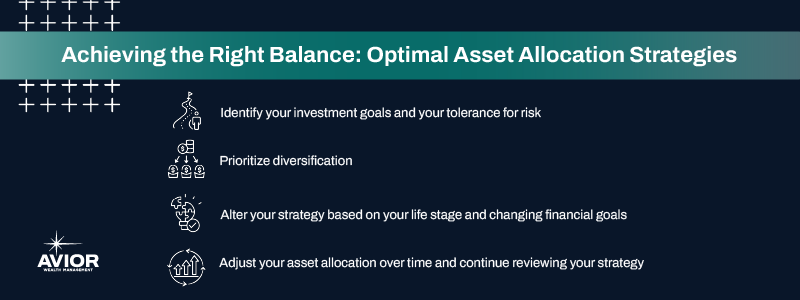Achieving the Right Balance: Optimal Asset Allocation Strategies
Asset allocation ensures you’re striking the right investment balance to meet your short- and long-term wealth management goals.

Effective wealth management requires careful assessment and balance. Assets need to be allocated to meet your investment goals while managing risk – a concept known as asset allocation.
Finding the right balance can be a struggle, though. What is considered a desirable portfolio is different for investors since everyone has their own objectives and priorities.
How do you balance asset classes effectively without excessive risk or insufficient growth potential? This guide walks through actionable strategies for harmonizing investments in your wealth management journey.
Understanding your investment goals and risk tolerance
Your risk tolerance is your ability and willingness to withstand fluctuations in the value of your investments. This tolerance is influenced by your financial situation, time horizon, emotional resilience, and more. By honestly evaluating how much risk you’re comfortable with, you can avoid making impulsive decisions during market downturns and stay committed to your long-term investment plan.
Setting realistic investment goals involves a thoughtful consideration of your financial objectives. You could be saving for retirement, a home, education, or other financial milestones. Clearly define your goals to determine the appropriate investment strategy. Your goals should be specific and measurable so you can track them over time.
Your risk tolerance and investment goals play a pivotal role in determining the appropriate mix of assets in your portfolio. For example, if you have a higher risk tolerance and a long-term investment horizon, you may allocate a larger portion of your portfolio to stocks, which historically offer higher returns but come with increased volatility. Conversely, if your risk tolerance is lower or your investment horizon is shorter, a more conservative approach with a higher allocation to bonds or cash may be suitable.
Your best bet? Diversify.
Diversification: The key to balancing risk and return
Diversification is a fundamental principle of investing, helping you balance risk and return. At its core, diversification involves spreading investments across a variety of assets to reduce the impact of a poor-performing investment on a portfolio. It aims to mitigate the impact of individual asset volatility and enhance the stability of your overall portfolio.
Different asset classes, such as stocks, bonds, and cash, have distinct risk and return profiles. For instance, during periods of economic growth, stocks might perform well while bonds may offer stability. During economic downturns, bonds might outperform stocks. Through diversification, a portfolio becomes less susceptible to the negative impact of a single asset class experiencing volatility or underperformance.
A traditional diversified portfolio might include a mix of domestic and international stocks, government and corporate bonds, and perhaps some real estate or alternative investments. Each asset class reacts differently to economic conditions and market events, providing a level of protection against unforeseen challenges. This concept is key to grasp when focusing on asset allocation.
Next, we’ll cover asset allocation strategies
Asset allocation strategies for different life stages and financial goals
Your asset allocation approach will vary based on where you are in life, how close you are to retirement, and your unique wealth management goals. Here are strategies that correlate with different life stages and common financial goals for these stages:
Young investors
Younger savers are those in their 20s and 30s. Often, they’ll take a more aggressive approach to investing, since they still have many years ahead of them before retirement. This means allocating more to stocks for that long-term growth potential.
Investors around this age may have goals focused on accumulating wealth after college or getting their first job and getting started with retirement planning.
Mid-career investors
The next group of investors are those from their 30s to 50s. Because they’re more mid-career now, they should aim to maintain a mix of stocks and bonds so that risks are managed but they continue to see substantial growth with their investments. This age group is more likely to consider investing in real estate for the long term.
Financial goals for this group are often saving for major life events, like buying a home, paying for a wedding, or covering children’s education. They are continuing to build their retirement funds as well.
This is when investors should take a closer look at their risk tolerance, though it should be considered at each stage. Risk tolerance helps you come up with the right balance when you work with your financial advisor. Whatever decision you make needs to align with your comfort level.
Investors nearing retirement
This next group is made up of people in their 50s and up. They’re getting close to retirement so they need to think through how they can make their portfolio a bit more conservative. This means allocating more toward bonds to protect all the wealth they’ve accumulated over the years.
Goals for this stage include capital preservation, generating retirement income, and fine-tuning their portfolio for a smoother transition into retirement. In the income generation realm, it may be wise to shift toward income-generating assets like bonds and dividend-paying stocks to supplement retirement income.
Strategies for all stages
All three stages should include allocations to emergency funds and other liquid assets in the event of unexpected expenses, like home repairs or medical costs. Saving for these circumstances helps you avoid disrupting long-term investment goals.
Depending on your unique plan, you may also need to incorporate education and homeownership goals throughout your life stages. Consider goals for your and your children’s education and allocating funds for a home purchase.
Next, find out the importance of a regular portfolio review.
Adjusting asset allocation over time
Adapting asset allocation strategies to different life stages and financial goals is crucial for optimizing your investment outcomes and ensuring a secure financial future. However, regular reviews and adjustments still need to be made, which contribute to a well-rounded and dynamic investment approach. Adjust your asset allocation strategy based on changes in your financial goals, market conditions, and personal circumstances.
It’s always important to walk through your options and goals with a tax professional, who is key in these regular reviews. Technology can also help, as many investment companies provide robo-advisors to help you allocate effectively based on the market. However, nothing compares to professional financial advice from a financial advisor who will help you develop and maintain an optimal asset allocation strategy based on your goals and desires.
Why embrace flexibility in asset allocation?
One thing you’ll learn over time is that flexibility is a must for successful investing. Your goals, income status, family situation, or priorities may change over time, so you need to view your asset allocation strategy as a living thing that requires regular attention.
Effective asset allocation should be based on your life stage and financial goals, but also on how comfortable you are with risk. Diversification is always wise so you don’t lose everything in a market swing.
Want to continue learning and adapting with a financial advisor from Avior? Get in touch to learn about our wealth management services.
Disclaimer: Nothing contained herein should be construed as legal or tax advice. Avior and our Advisors will work with your attorney and/or tax professional to assist with your legal and tax strategies. Please consult your attorney or tax professional with specific legal and/or tax questions. Investment Management and Financial Planner are offered through Avior Wealth Management, LLC, an SEC-registered investment advisor. Past performance is not a guarantee of future results. Investments are subject to loss, including the loss of principal.
No Comments
Sorry, the comment form is closed at this time.




